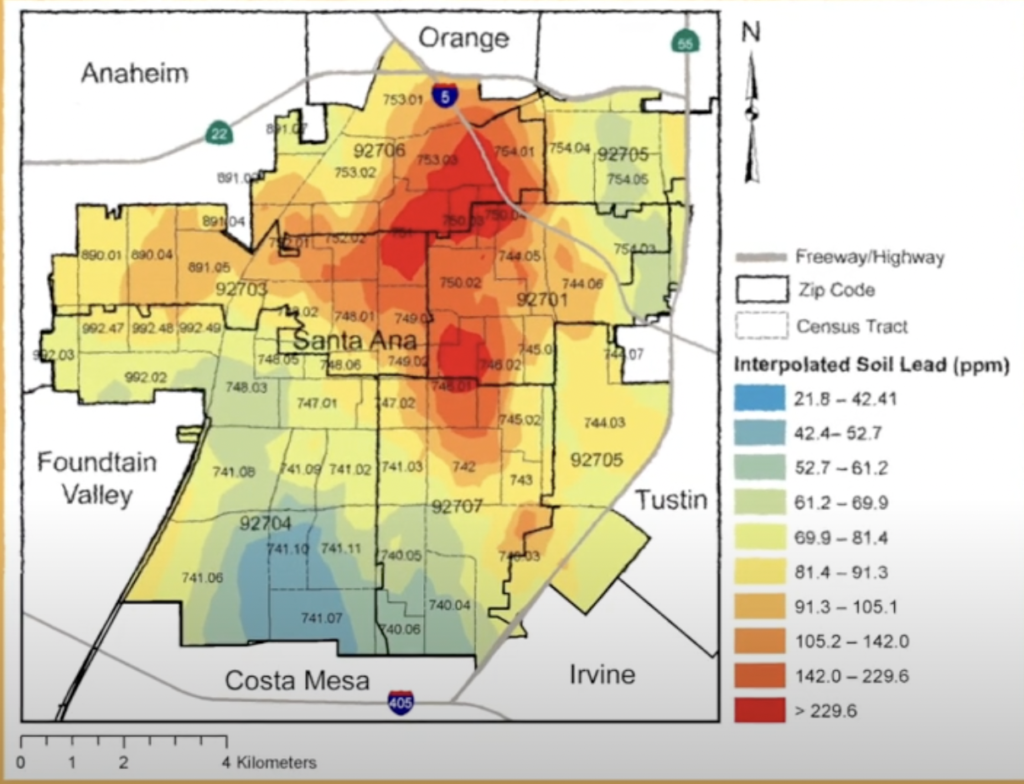The detection of federally unsafe levels of lead within soil throughout Santa Ana, by a group of UC Irvine students, has spotlighted worrisome environmental hazards in Orange County and caught the attention of the Environmental Protection Agency.
UC Irvine students from scattered disciplines ranging from civil engineering, anthropology and environmental science received a first place award in the Environmental Protection Agency’s Environmental Justice Video Challenge by uncovering hazardous levels of lead within Santa Ana soil.
In addition to the discovery of unhealthy amounts of lead in soils, the team was able to correlate that there were higher concentrations of lead in lower-income neighborhoods.
However, they say more needs to be done.

Laid out in a six-minute YouTube video titled “Unearthing Lead: The Power of Historical Maps”, the team details a decade-long lead crisis in Santa Ana.
Dr. Jun Wu, an environmental health scientist and professor of Public Health at UC Irvine, explained that the main culprit of lead in soil tends to be house paint, which eventually breaks down and seeps into soils. Juan Manuel Rubio, a historian at UC Irvine, explained that the historical impact of automobiles, which ran on leaded gasoline for a time, can also be to blame.
Patricia J. Flores Yrarrazaval, who is a member of Orange County Environmental Justice, said through the collection of soil samples in Santa Ana, taken by ZIP code, the UC Irvine team found levels much greater than the California safety standards of 80 PPM.
“Large swaths with lead levels of 80 parts per million. That number is what Cal EPA designates as the safety threshold – where it starts to affect children and their developmental health,” he said. “We have a lot of neighborhoods in Santa Ana, Madison Park Neighborhood and the Evergreen neighborhood with soil lead levels 25 to 50 times higher than the threshold for safety that Cal EPA designates.”
Tim Schütz, anthropology Ph.D. candidate and videographer, said this was an important step in improving health and bringing awareness to communities regardless of socioeconomic status.
“This award is a recognition of the collaborative relationships our team built between OCEJ and UCI researchers. Moving forward, the video will help launch the next phase of communicating the research findings on the national level, with the possibility to inspire action in similarly impacted communities,” Schütz said. “It also supports my dissertation research about the role of data and digital technology in environmental activism. As part of the award nomination, our team is planning to submit a peer-reviewed journal article that discusses the use of videos, podcasts and other creative media that help make lead soil contamination a matter of public concern.”
Chris Frey, assistant administrator for EPA’s Office of Research and Development, spoke highly of the project, adding that this project demonstrates that collaboration is a powerful tool.
“Addressing environmental justice concerns is a core part of our work at EPA,” Fey said. “This challenge empowered young people to bring attention to important environmental and public health issues. I look forward to seeing how students collaborate with communities to advance environmental justice in the second phase of this challenge.”
With their first-place EPA Environmental Justice Award, the UC Irvine team received $20,000 and a chance to compete in Phase 2, which will launch in September.
Advertising disclosure: We may receive compensation for some of the links in our stories. Thank you for supporting Irvine Weekly and our advertisers.

